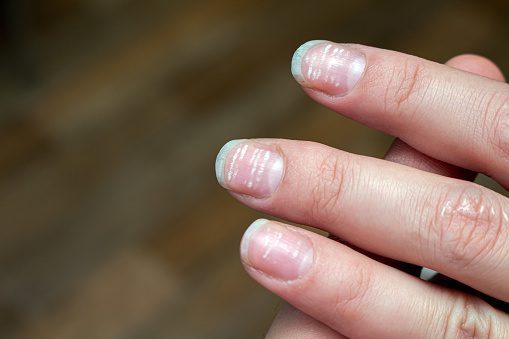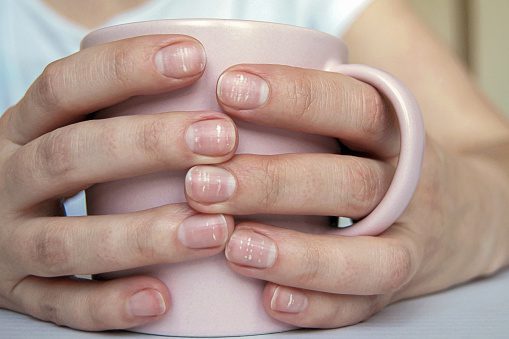Have you ever spotted tiny white marks on your fingernails and thought, “Ah, I must be low on calcium”? You’re definitely not alone. For years, we’ve been told these mysterious specks are the telltale signs of nail plate calcium deficiency, but is there any truth to it?
Alerta de spoiler: no es cierto.
Let’s break it all down and uncover what your nails are actually trying to tell you, without jumping to conclusions about your milk intake.



¿Es real la deficiencia de calcio en la placa ungueal?
First things first, let’s talk about what the nail plate actually is. Your nails are made of queratina, a strong protein also found in your hair and skin. They grow out from the nail matrix, the area beneath the base of your nail, and gradually harden as they push forward.
La verdad es que esos puntitos blancos, llamados parciales leuconiquia, are caused by minor trauma to the nail matrix. While those little nail plate cells are travelling from the nail matrix and through the eponychium where the cuticle is attached before those nail plates appear from under the Proximal Nail Fold, they are going through a transformation process. Sometimes, something like an aggressive manicure could possibly cause the problem. Still, according to medical science, it happens when the nail plate cells are supposed to compress and become transparent but (for some reason) they don’t and remain as little, opaque, unfinished nail plate cells.
Sea cual sea el caso, algo interfiere en la forma en que se forman las células de la uña, dejando tras de sí una pequeña zona opaca que se hace visible semanas después.
Así que no, tus manchas blancas no están pidiendo a gritos un suplemento de calcio.
¿Qué son las manchas blancas en las uñas y cuáles son sus causas?
White spots within the nail plate, often referred to as partial leukonychia, are usually caused by minor injury to the nail matrix beneath el eponiquio. When the matrix is disrupted, some nail cells may be pushed out before they are fully developed. These immature cells appear as pale or white spots as they grow with the nail. Once the injury heals, the nail matrix produces normal cells again. Larger clusters of these underdeveloped cells can create a soft area in the nail, so extra care should be taken when preparing the nail plate for artificial nail products. To be sure you are looking at partial leukonychia, apply a little pressure on the nail plate, and if that white spot remains white, then you are; if the color changes it’s something else.
Cambios en las uñas y su significado Visite Media
Although calcium isn’t to blame, your nails can still reflect aspects of your health. The key is to know what kinds of changes matter and which ones are just surface-level quirks.
Here’s a quick cheat sheet:
- Manchas blancas: Suele ser el resultado de un defecto en el proceso de compresión o de un traumatismo leve en el eponiquio o a su alrededor, no de deficiencias nutricionales.
- Crestas: Las crestas verticales son comunes con la edad. Las crestas horizontales profundas (Beau’s lines) podría indicar una enfermedad pasada, un shock o incluso un momento grave de estrés.
- Suave o uñas quebradizas: Often due to excessive water exposure, frequent handwashing, or harsh nail prep techniques, rather than diet.
- Amarillea: Esto podría ser de esmalte de uñas, psoriasis, alopecia, lichen planus or a infección fúngica.
La conclusión es que no todos los cambios en las uñas están relacionados con la nutrición y, desde luego, no con una deficiencia de calcio en la placa ungueal.
The Truth About Calcium’s Role in Nail Plate Health
Para ser justos, el calcio desempeña un pequeño papel de apoyo en la salud general de las uñas. Contribuye a la estructura de las células, y una carencia extrema a largo plazo podría afectar a la calidad de los tejidos en crecimiento, incluidas las uñas. Pero esto es poco frecuente en la mayoría de las personas bien alimentadas.
La carencia de calcio tiende a manifestarse en los sistemas más críticos, como los huesos y los dientes.
If you’re consuming enough calcium through your diet, such as from dairy, leafy greens, almonds or fortified plant milks, you’re more than likely meeting your body’s needs.
Y si tus uñas están débiles o escamadas, probablemente el culpable sea más externo que interno. Aquí hay 2 factores más:
- If you have a short nail matrix you will have thin nails.
- If you file the nail plate too aggressively during nail prep, you will damage the essential structure of the nail plate needed to maintain its strength and flexibility, causing excessive nail weakness and creating even more flaking & delamination.
Mitos comunes sobre la deficiencia de calcio en la placa ungueal
It’s easy to get caught up in old wives’ tales and internet wellness tips, so let’s clear up a few more common myths.
- Myth: Biotin and calcium supplements will fix all nail issues.
Truth: They might help if you have a diagnosed deficiency, but most people won’t see dramatic improvements unless there’s an actual imbalance. - Mito: Beber más leche fortalecerá tus uñas.
Truth: While milk is a source of calcium, your nails aren’t thirsty for it in the same way your bones are. Your nails do love nail oil, but drinking it will not help. Rub it in gently after applying it behind the free edge of the nail plate, allowing it to run into your lateral nail folds. The warmth created by rubbing will help the oil penetrate your nail plate. - Mito: Todos los problemas de las uñas significan que algo va mal en la dieta.
Truth: More often, it’s your daily habits, such as biting, picking, washing, or harsh nail prep treatments, that are to blame. - Mito: Limar el borde libre de la lámina ungueal en una dirección evitará que se parta.
Truth: A 120grit diamond nail file will tear up the free edge of the nail plate regardless of which way you file it. It’s better to use 180-240 grit file applying gentle, even pressure to avoid this happening.
Cómo cuidar realmente la lámina ungueal
En lugar de perseguir el mito de la deficiencia de calcio en la placa ungueal, concéntrese en estos hábitos reales para el cuidado de las uñas.
Hidratar, hidratar, hidratar: Utiliza regularmente aceites de alta calidad para uñas y piel en combinación con cremas o exfoliantes de manos de alta calidad para evitar que las uñas y la piel se sequen y se descamen.
- Protege tus manos: Utilice guantes al limpiar o lavar los platos para evitar sobreexposición al agua y productos químicos.
- Archivar correctamente: Utilice una lima de grano 180-240 al limar el borde libre para evitar daños adicionales.
- Don’t pick or bite: It may be a nervous habit, but it’s also one of the quickest ways to damage the nail plate and surrounding skin.
- Seguir una dieta equilibrada: Incluye muchas proteínas, omega-3 y hierro, zincpara mantener las uñas desde dentro. La matriz de la uña obtiene sus nutrientes de la sangre y sólo de la sangre, cuanto mejor sea tu dieta, mejores serán tus uñas.
Reflexiones finales sobre el déficit de calcio en la placa ungueal
While it’s tempting to blame white spots or brittle tips on a nail plate calcium deficiency, the science just doesn’t back it up. More often than not, your nails are reacting to the everyday wear and tear they go through. Whether that’s a knock on the table, frequent handwashing, or a particularly aggressive manicure, these things have more of an impact than a glass of milk ever could.
So the next time someone points to your nail and says, “You need more calcium,” feel free to drop a little knowledge. Your nails are complex, yes, but they’re also surprisingly resilient. With the right care and a bit of myth-busting, they’ll stay strong and healthy without needing a trip to the dairy aisle.
Lecturas complementarias
Think those white spots on your nails mean you need more calcium? Not quite! While it’s a common myth, the truth behind those marks is more complex. Learn what actually causes white spots and lines on nails in our in-depth guide on leuconiquiaQué es, por qué se produce y qué significa realmente para la salud de las uñas. Más información.


